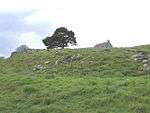Badenyon Castle
Badenyon Castle was a castle, dating from the 13th century around 7.5 miles (12.1 km) west of Kildrummy, north of Coulins Burn, in Aberdeenshire, Scotland.[1]

History
The castle was the residence of the Clan Gordon of Glenbuchat prior to the building of Glenbuchat Castle in 1590, although traditionally it was the home of John O'Badenyon in the 13th century.[2]
By 1898, a few pieces of sandstone against the wall of an adjacent cottage, and a recessed door inside were all that remained of the castle.[2]
Structure
The castle was surrounded by a fosse and protected by a tower. A door-hinge from the nearby steading is said to come from the castle. The precise site of the property in not entirely clear.[2]
gollark: ++help
gollark: eßolang
gollark: I suppose copying itself over the public internet would be slow and attract suspicion.
gollark: Ah yes, of course.
gollark: I suppose it *is* hard to construct microprocessors, given the tolerances and stuff, but it could rent a VPS somewhere.
References
- Coventry Martin (1997) The Castles of Scotland. Goblinshead. ISBN 1 899874 10 0 p63
- "Badenyon Castle". Retrieved 1 November 2014.
This article is issued from Wikipedia. The text is licensed under Creative Commons - Attribution - Sharealike. Additional terms may apply for the media files.